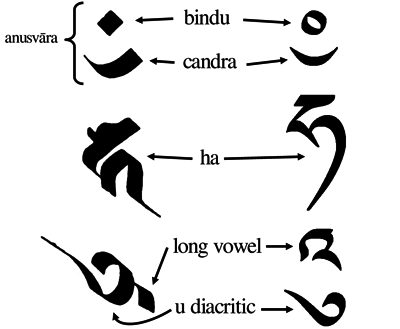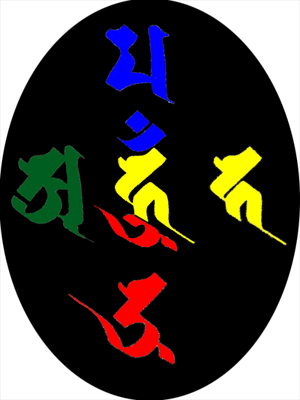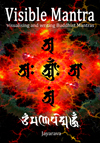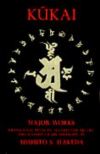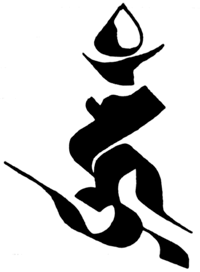
In his Ungi gi Kukai makes hūṃ a cipher for understanding the Truth. The various aspects take in all Truths, all teachings, all practices, and all attainments. It summarises the two basic false views of nihilism and eternalism, and shows them to be false. The Truth of things is that they are neither real nor unreal, these categories do not apply – this is a restatement of the Buddha’s fundamental insight into the nature of phenomena, couched in the language of the Madhyamika.
Pronounced /hũː/ (IPA)
How to write the hūṃ seed syllable in Siddhaṃ.
Other bījas: a | āḥ | dhīḥ | hrīḥ | maiṃ | oṃ | tāṃ | traṃ | phaṭ | svāhā |
Examples
 |
हूँ |  |
 |
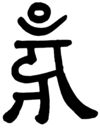 |
| hūṃ Siddhaṃ alternative |
hūṃ Devanāgarī |
hūṃ Tibetan (Uchen) |
hūṃ Lantsa |
hūṃ Immitation Chinese Seal Script |
| (ma) ṃ | ||
| a | hūṃ | ha |
ū | ||
Note: sometimes ṃ is said to be equivalent to ma for the purposes of this kind of exercise, so I have included both.
Kūkai discusses hūṃ on three levels: invariant, ultimate, and synthetic. Each aspect of hum is capable of infinite associations.
The invariant meanings are the esoteric associations via the alphabet of wisdom, thus: ha = hetva (cause); a = anutpāda (unarisen); ū = ūna (wanting); and ṃ = ātman (self). In practice we would take each element as a meditation practice by inserting it into a general forumla e.g. The seed syllable ha is a door to all dharmas because they are without cause. The idea being that each phrase, one for each of the letter of the alphabet, points to the the śunya nature of dharmas - ie that they lack svabhava or self-being. For more on this see the A as a Dharma Door calligraphy.
The ultimate meanings are difficult to sum up simply because the possible associations are so extensive and the Ungi gi is a very dense and terse text - summaries which do justice to the text end up being the same size as the text itself. All I can do here is offer some indications to give a taste and suggest the reader gets hold of Ungi gi.
The ultimate meaning of a is that it is the first sound and therefore represents relative being; it is non-arising and therefore empty (śunya); a is also uncreated and therefore is the source of all things. A is the first sound because it begins the alphabet, it is the first sound that comes when you breath out, and it is said to be present in all letters - consonants have an implicit accompanying a vowel.Because of ha the 1st cause is unobtainable we should know that predications of all things are our mind only and that the real feature of our mind is all-inclusive wisdom. Ū means that because all things are ūna, or wanting, the ultimate meaning is that no existence is found wanting of Buddhahood; the 'One Mind' is perpetual and doesn't increase or decrease; it is eternity, bliss, the Self, purity, in short the nature of Suchness pervades all beings. Finally the ultimate meaning of ṃ is the all-embracing equality, the transformation of Mahāvairocana into all things, it is the sole great self of selfless existence.
Note that although Kūkai adopts the language of permanence and even Self (Ātman), he is not negating the principle of pratītyasamutpāda: the contradiction is more apparent than real. Kūkai accepts a radical form of the idea that all things interpenetrate that is not explicit in pratītyasamutpāda but which can be deduced from it, and came to prominance with the Avatamsaka Sūtra around the 2nd century CE. In this view all dharmas are fully and perfectly interpenetrated by all other dharmas - and this includes the Buddha and the principle of Buddhahood (Dharmakāya). The whole mess is not solid and real, but neither is it illusion and unreal. Neither real nor unreal can fully describe reality. We must keep in mind that Kūkai's rhetoric is shaped partly by the early Vajrayana texts, but also as a reaction to the scholastic formalism in 9th century Japan.
Kūkai's synthetic meanings can be glossed as: ha summarises all religious teachings; a is absolute reality; ū includes all religious practices; while .m encompasses all religious attainments. The a bīja symbolizes the Dharmakāya; it is neither being nor non-being, nor both, nor neither, being beyond such dualities; a is the negative prefix in Sanskrit which forms a negative to any word when added to the beginning; this is the truth tha all Buddhists teachings are pointing to so a summarises them all.
In Kūkai's analysis then hūṃ is a hermeneutical device which can unlock the true nature of reality. It is massively polyvalent, which is to say that it has almost infinite meaning because of the network of associations that it sits at the center of.


